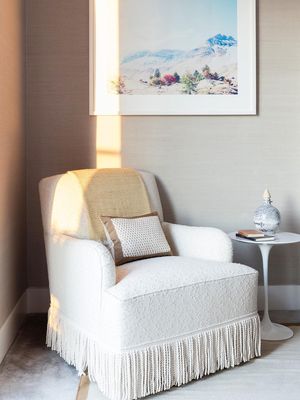

Interiors Trend Watch: Fringing
When did fringing first become popular?
“Fringing was popular during the Georgian era when Britain was flush with money and the wealthy suddenly took an interest in embellished living. Colours were bright, fabrics were lavish and trimmings were everywhere. It was such a fun and vibrant time, so it’s no wonder we refer back to it today when it comes to decorating our interiors.” – Steven Collins, owner of Henry’s Townhouse & Temple Guiting Manor
“Historically, trimmings and fringes have been used to indicate status – you’ll often see them depicted in paintings, on wall hangings, on canopies, beds, cloths and cushions. Fringing was originally used as a way of preventing fabric from unravelling, but today it’s usually bought separately and sewn onto a piece of fabric.” – The team at Salvesen Graham
Why was it used?
“As mentioned, fringing was historically used as a way of portraying wealth and luxury on clothing and uniforms. While matters of taste changed throughout history and continue to do so, fringes continue to be a popular way to ‘finish’ pieces.” – Salvesen Graham
Why is it popular again?
“Like with all things, trends come and go, and we’re always looking to the past for inspiration on how to live today. Five years ago, you wouldn’t have dreamt of buying ‘brown’ furniture for example, but now antiques are hugely popular again. The same goes for fringing. The same issue around wealth might not be as prevalent, but those who can afford to use it do so to take things to the next level.” – Steven
““Fringing really taps into the maximalist trend – which is taking hold everywhere from fashion to interiors – as it embraces the bold use of colour, pattern and layering to create a space that celebrates more-is-more. It’s a curated and international way to be more adventurous and it makes a piece of furniture go that extra mile.” – Lucy Barlow, co-founder of Barlow & Barlow
How can it be used in a more contemporary way?
“As with all interior design trends, the key to successful fringing is in the mix. You don’t want to turn your home into some sort of cliché or tribute to a particular era, so you have to be careful about what you pair things with. Mid-century furniture, for example, works really well with contemporary touches but you wouldn’t want to mix mid-century with Rococo. Contrasting and creating unusual combinations is the way to bring things up to date.” – Steven
How do you like to use it?
“I like mixing and matching trimmings, but we do always seek out original bits of fabric as opposed to anything too modern. Because fringing is so delicate, it does need replacing often. But that’s also the beauty of it: unlike reupholstering a whole sofa or adding a new sideboard to a room, changing up the trimmings is an easy and low-cost way of breathing new life into a room.” – Steven
“We either like to choose a tone that blends in with the upholstered fabric or to use a contrasting colour that makes the upholstered fabric sing. Fringing instantly injects personality into a space, in turn creating a mood-boosting aesthetic. Just remember to choose a colour that will complement the tones found elsewhere in the room.” – Lucy
What furniture does it work best on?
“I love it on lampshades, around footstools and along the edges of sofas but, again, you have to be careful not to go overboard. One item per room looks best – I’ll make an exception for a pair of footstools though, because that always looks good.” – Steven
What combinations of fabric and fringing do you like?
“Velvet fringing on linen fabric always works well and is a great way of making fringing a bit more modern. I also love silk fringing on velvet or silk on silk, which feels quite opulent. Lace trimming works well on silk as it makes it feel very romantic and feminine.” – Steven
Are there rules around how long the fringing should be?
“If there are then we certainly do not abide by them. My wife Jane has always had the most incredible eye and all of her work on all of our properties is completely instinctive. I think most people just know when something works and when something doesn’t.” – Steven
Finally, what mistakes do people make with fringing?
“Getting carried away and fringing the whole room! As I said before, try to stick to one item in the space – this is the sort of adornment that can start to look cheap if it’s overdone.” – Steven
““Definitely avoid overhanging fringing, as people can stand on the ends which leads to fraying – such a pain. Try leaving a couple of centimetres between the floor and the end of the fringe to avoid anyone from pulling on it or it becoming dirty.” – Lucy
DISCLAIMER: We endeavour to always credit the correct original source of every image we use. If you think a credit may be incorrect, please contact us at info@sheerluxe.com.


